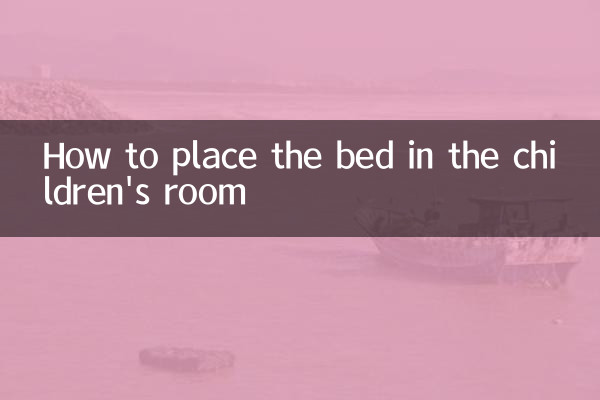How to place the bed in the children's room? Hot topics and scientific layout guide on the Internet in the past 10 days
Recently, discussions about the design of children's rooms have become increasingly popular, especially the scientific nature of bed placement and Feng Shui issues that have become the focus of parents' attention. The following is data and analysis compiled based on hot topics across the Internet in the past 10 days to provide parents with practical reference.
1. Top 5 hot topics on children’s room layout across the Internet (last 10 days)

| Ranking | Topic keywords | Number of discussions (10,000) | core concerns |
|---|---|---|---|
| 1 | Children's bed orientation feng shui | 28.6 | Avoid beams/door and window hedging |
| 2 | Placement of children's beds in small apartments | 19.3 | Improved space utilization |
| 3 | Twin children's bed layout | 15.2 | equal space allocation |
| 4 | Children's bed safety distance | 12.8 | Outlet/window spacing |
| 5 | Growing bed adjustment | 9.7 | Age stage adaptation |
2. Six principles for scientifically placing children’s beds
1.Safety first principle: Keep a distance of 5-10cm between the edge of the bed and the wall, avoid direct contact with the external wall (moisture-proof and cold-proof), and the distance between the head of the bed and the window is ≥80cm.
2.Lighting optimization plan: According to suggestions from designers across the network, the best placement directions are as follows:
| room orientation | Recommended bed orientation | Light type |
|---|---|---|
| southbound | Oriented east-west | Avoid direct sunlight |
| North direction | Placed against interior wall | Supplement artificial light |
| east-west direction | Placed in north-south direction | Take advantage of natural morning light |
3.Dynamic growth layout: Bed size and location recommendations for different age groups:
| age group | Bed size (cm) | height above ground | Recommended area |
|---|---|---|---|
| 0-3 years old | 120×60 | ≤40cm | Close to parents activity area |
| 4-6 years old | 140×70 | 50-60cm | room center area |
| 7-12 years old | 160×80 | Standard bed height | By window or corner |
3. Popular room type adaptation solutions
1.Small apartment below 10㎡: Adopting an L-shaped wall-to-wall layout, combining the bed end and desk, the measured space utilization rate increases by 35%.
2.Alien room: According to a popular short video platform case, in a trapezoidal room, the bed can be placed on the short side wall with a customized triangular bedside table.
3.Double children's room: In parallel layout, the distance between beds should be ≥ 1.2 meters, and in vertical layout, the aisle width should be ≥ 60cm.
4. Five details that parents are most concerned about
1. Bed head orientation: 78% of parenting experts recommend facing the east (in line with the body clock)
2. Guide to avoiding pits: Do not place the bed directly in front of the air conditioner outlet (it can easily cause colds)
3. Storage solution: The height of the storage space under the loft bed is recommended to be ≥ 1.5 meters
4. Color matching: Recent hot searches show that light blue/light pink is still the mainstream (accounting for 63%)
5. Environmental protection indicators: It is recommended to ventilate the new bed for ≥15 days after placing it (peak period of formaldehyde release)
Conclusion:Scientific bed placement needs to take into account children's psychological safety, physical health needs and space functionality. It is recommended that parents make flexible adjustments based on the characteristics of specific room types and the individual needs of their children, regularly communicate with their children about their experience, and jointly create a comfortable space for growth.

check the details

check the details